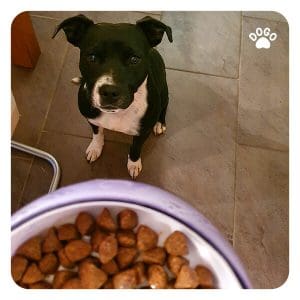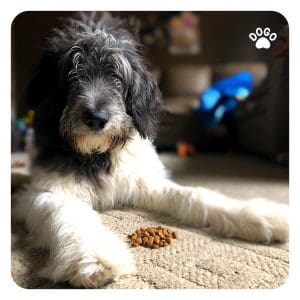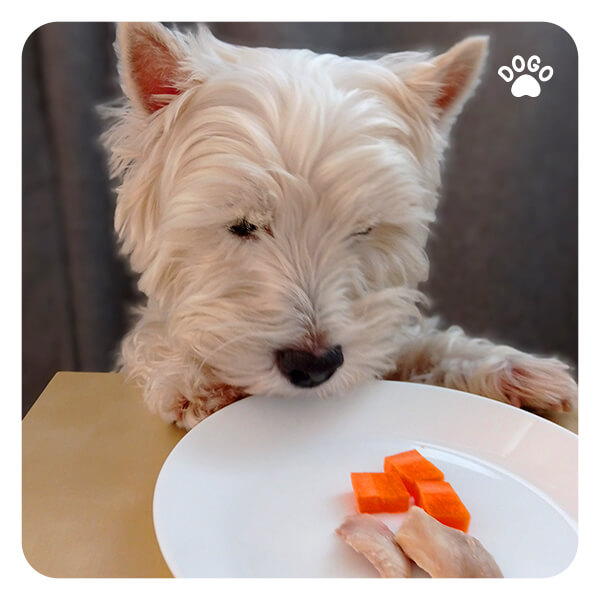Are you not sure how much food you should feed your dog? How to know if you give your pup too much or too little food? The answer to those questions depends on several factors, such as your dog’s size, metabolism, speed, and type of food. We will analyze all the important points in this article.
Dry Dog Food
 To learn how much food you can give your pup, first of all, we recommend following the guidelines you can find on the food label. They are usually located on the bag’s or can’s side. This is the first thing to check that will help you get a general idea of how much food you should give your dog.
To learn how much food you can give your pup, first of all, we recommend following the guidelines you can find on the food label. They are usually located on the bag’s or can’s side. This is the first thing to check that will help you get a general idea of how much food you should give your dog.
It is important to mention that there are different types of dog food. For example, standard, premium, and super-premium meals are prepared with different quality ingredients, influencing digestion’s speed.
- Dry food: digestion speed: from 8 to 16 hours
- Wet or pasty food: digestion speed: 4 to 6 hours
According to the research work “Determination of pre-anesthetic fasting time in dogs” by Jorge Luiz Costa Castro, Sérgio Santaalucia, Vinicius Gonzalez, and Alceu Gaspar, published in the Scientific Journal of Veterinary Medicine – Pequenos Animais de Estimação – 2016, dry food continues to be present in the stomach of dogs until the next 8 hours after ingesting the food, unlike wet food, which is no longer present in the following 4 to 8 hours.
That same research explains that the speed of digestion depends on the consistency of the food. The digestion of lipids is slow, proteins are fast and carbohydrates are intermediate. Water also interferes with the speed of digestion. Dry foods take an average of 8 hours, or even 14 and 16 hours to complete their digestion. However, wet food takes an average of 4 hours, reaching up to 6 hours.
Teshima et al. (2007) revealed digestibility coefficients of 70.59% dry matter, 71.49% organic matter, 72.44% crude protein, and 69.04% crude energy, using the yeast extract of the specific strain. Another study shows that high-quality dry foods can have 89%, 95%, and 88% digestibility for protein, crude fat, and carbohydrates, respectively (Case et. Al. 1998).
However, it is important to note that the guidelines on the food label are just a starting point. Every dog is unique, and their nutritional needs may vary based on their age, breed, activity level, and overall health. Therefore, it is crucial to consult with a veterinarian to determine the appropriate amount of food for your dog. A vet can also help you choose the right type of food for your dog’s specific needs, whether it be dry, wet, or natural food. Additionally, if you notice any changes in your dog’s appetite or weight, it is essential to seek veterinary advice as soon as possible.
Natural Food
 Another tip that can help you estimate your pup’s daily nutrition dose is to know that dogs should consume 4-5% of their weight daily. If the weight is less than 10 kg, but more than 35 kg, this number increases for small dogs and decreases for larger dogs due to their metabolism speed. Make sure to get approval from a trusted vet before creating a natural diet for your dog.
Another tip that can help you estimate your pup’s daily nutrition dose is to know that dogs should consume 4-5% of their weight daily. If the weight is less than 10 kg, but more than 35 kg, this number increases for small dogs and decreases for larger dogs due to their metabolism speed. Make sure to get approval from a trusted vet before creating a natural diet for your dog.
When it comes to natural food, it is essential to ensure that your dog is getting a balanced diet that includes all the necessary nutrients. A balanced diet should consist of protein, carbohydrates, fats, vitamins, and minerals. It is also crucial to avoid feeding your dog any toxic foods, such as chocolate, grapes, onions, and garlic. Additionally, it is important to note that natural food may not be suitable for all dogs, especially those with certain health conditions. Therefore, it is crucial to seek veterinary advice before switching to a natural diet.
Digestion Speed
Natural cooked (boiled) food, as it is high quality and easily digested food, has a speed of digestion and digestibility similar and/or equal to that of humans, specifically, in the ingestion rich in carbohydrates, where the postprandial glycemic response complete between 4 and 6 hours (Bouchard, Sunvold, 2000; Appleton et al., 2004). In other words, most likely, when you are hungry, your dog will be hungry too.
Generalizing, the speed of digestion is 4 hours, due to being a wet food. Therefore, depending on your dog’s needs, it would be ideal to divide the food into 3 or 4 portions, according to the recommendations of your veterinarian specialized in canine natural nutrition.
The digestibility of natural food, raw or cooked (boiled), shows very high digestibility coefficients. In certain natural foods that have lower digestibility, cooking improves digestibility (Tavares et al. 2010). Another study shows us that some super-premium dry foods achieve nutrient digestibility and fecal quality similar to that of natural foods (Conventional versus natural foods for adults – Universidade Federal de Lavras – Janine França 2009).
How to Know Whether You Give Your Dog Too Much or Too Little Food?
 By observing your dog’s shape and touching them, you will know if your dog is eating too much or not enough. Generally, dogs have a body shape with a slightly narrower waist (seen from above). The last ribs must be visible (dogs with little hair), or you should be able to touch and feel them (dogs with medium or a lot of hair).
By observing your dog’s shape and touching them, you will know if your dog is eating too much or not enough. Generally, dogs have a body shape with a slightly narrower waist (seen from above). The last ribs must be visible (dogs with little hair), or you should be able to touch and feel them (dogs with medium or a lot of hair).
However, there are other signs that can indicate whether your dog is eating too much or too little food. For example, if your dog is stealing food, it may be a sign that they are not getting enough to eat. On the other hand, if your dog is lethargic, has a decreased appetite, or is losing weight, it may be a sign that they are eating too little. It is also important to monitor your dog’s bowel movements. If your dog’s stool is consistently loose or firm, it may be a sign that they are not getting the right amount of food.
Also, keep in mind that asking for food is a natural behavior among dogs. If your dog shows no interest in eating, it could be a sign that they are full.
Coprophagia (ingestion of feces) can have multiple causes, such as, for example, poor absorption of nutrients, which results in a nutritional deficit. Consult a veterinarian to find out why and consider changing the type of food that is being offered to the animal or even fractionating the food so they can eat more times during the day, due to the speed of digestion and differences in the digestibility of different foods.
To learn more on how to calculate the correct amount of calories your dog should consume a day, read this article: How many calories should my dog get per day?
Trust a Specialist
 As a responsible pet parent, you want to be 100% positive that you do everything to keep your pup in the best physical (and mental) shape. If you see your dog’s behavior has changed – e.g., your pup sleeps more than usual, they don’t want to play, are not interested in their food, or on the contrary – after finishing their meal, they still search for food in the house, beg for your snacks or steal pieces of food from a dining table, it is a clear signal that something wrong is happening and you shouldn’t ignore it. In any of those cases, don’t hesitate to consult a veterinarian who will investigate the cause of your dog’s behavior and give you a hand in creating the right diet for your furry baby.
As a responsible pet parent, you want to be 100% positive that you do everything to keep your pup in the best physical (and mental) shape. If you see your dog’s behavior has changed – e.g., your pup sleeps more than usual, they don’t want to play, are not interested in their food, or on the contrary – after finishing their meal, they still search for food in the house, beg for your snacks or steal pieces of food from a dining table, it is a clear signal that something wrong is happening and you shouldn’t ignore it. In any of those cases, don’t hesitate to consult a veterinarian who will investigate the cause of your dog’s behavior and give you a hand in creating the right diet for your furry baby.
[/fusion_text]



